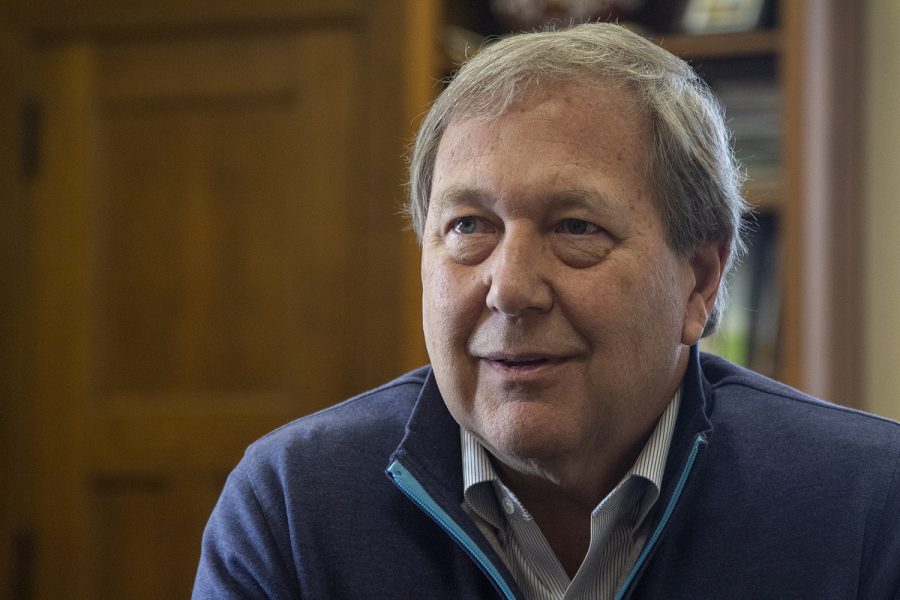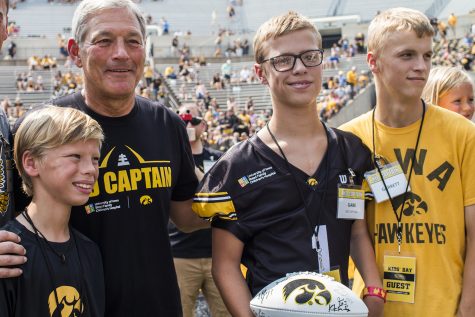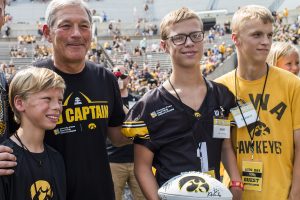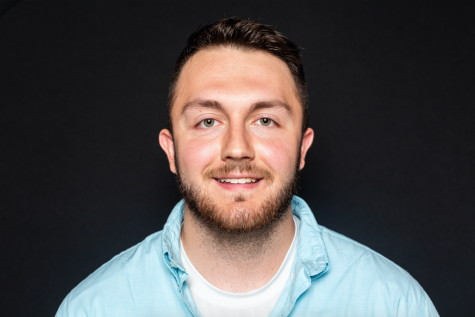Q&A: UI President Bruce Harreld talks state funding, student life
UI President Bruce Harreld spoke with The Daily Iowan on Dec. 7 about UI student life and dwindling state funding for Iowa’s universities.
UI President Bruce Harreld speaks with The Daily Iowan in an interview in the President’s Office on Friday, Dec. 7, 2018.
December 12, 2018
The Daily Iowan: In November, the regents approved the UI’s request to close the Labor Center and other centers and institutes, and community members continue to protest the decision in hopes of securing support from the university. Have you been a part of those conversations since its closing, and do you think that there are ways that the UI could still support the Labor Center?
Harreld: I think the key question in my mind is, is the Labor Center willing to support the Labor Center? We announced in June that there were a series of centers and institutes that could no longer be. I couldn’t subsidize them from student tuition. And so we said, “Hey look, you’ve got a year to find alternative sources of funding.” Many of them decided to close. And we actually sought the regents’ approval to close them all, just to make the process cleaner.
Many of them have, in fact, closed, several of them are looking for new alternative, sustainable, long-term sources of funding. I’m pretty optimistic some of them will come forward with such funding. The Labor Center seems to be stuck in a mode that says the university owes us, and this university should continue to subsidize $550,000. I’m frustrated with that, because that’s not going to happen. Now then, what might the university do? If they can find sustainable, long-term sources of funding, which I’m willing to work with them to find, then we would be glad to let them use our name, keep offices, keep using our payroll and administrative systems, so actually we’re contributing quite a bit in that process.
RELATED: UI commitment to Labor Center sought after regents approve closure
To date, no one from the Labor Center has reached out and said, “Please involve us in philanthropic or help us write grants or what have you.” But I am aware there’s a group of Labor Center leaders and state officials, as well as administration members, and actually in some cases the Board of Regents members are actively discussing what they might do. I’m still optimistic they’ll find something, but the clock is ticking.
Also … if they can find a long term source of funding, I’m more than willing to go back to the Board of Regents and ask to reinstate it. But I’m not willing to do that if the answer is we don’t have a long-term, sustainable source of funding. Just like anything else on the campus these days.
• • •
DI: In November, Kappa Sigma was suspended for facing hazing allegations, and there’s been a lot of focus on the issue of high-risk alcohol consumption in the greek community. Do you think this will prompt any larger conversations about hazing specifically, or are you hoping to see that as part of the 2020 Fraternity/Sorority Life plan?
Harreld: I don’t think this issue is going to go away really quickly, and I don’t think that this is one fraternity. I think that it’s a lot, and I think it’s a national issue. I think we need to have a dialogue about hazing, alcohol, drug use in the Fraternity/Sorority system, across not only our campus but our country.
RELATED: UI president discusses fraternity suspensions, safety on campus
We’re in the final stages of an investigation into what happened; we were pretty clear about what our policies were. We’ve put a lot of fraternities on notice. That it was unacceptable. I think we had a conversation a couple of months ago, and I basically said look, live the values. I’m a Sigma Chi, I can relate our values as a Sigma Chi. Just hold yourself up to those values, and everything will be fine.
RELATED: University of Iowa fraternity Kappa Sigma suspended, facing hazing allegations
People have done a lot of unfortunate things on campus, we’re trying to get all the facts and details. We’ll let that report finish, and then we’ll still have to make some decisions. I think, unfortunately, there has been a lot of unacceptable behavior. I continue to remind myself as a parent and grandparent that people, that parents don’t send their daughters and sons to institutions like ours and have them go through those types of experiences. We’ve had a couple cases in which students have died, they’ve been hazed, we’re not going to tolerate that anymore. And if that’s not acceptable, then we’ll have to find some other social system and reinvent something. And I’m more than willing, once again, to work with the campus. I know [Vice President] Melissa [Shivers] and the Division of Student Life are working aggressively with all the members of that community. But here we are, and it is unfortunate.
• • •
DI: Last month, we finally got a look at the regents’ multiyear tuition model, and you told the *DI* after the meeting that you think it’s better for students because of its predictability, but can you take us through your thoughts again on why it’s better for students?
Harreld: Everything is relative in life. You have to look at where we’ve been for the last several years, and we’ve been on-again, off-again. We set a tuition target in September, and it turns out we get de-appropriated somewhere in the winter term by the state, and then we do another tuition increase in the springtime. I think that’s on-again, off-again, and I think that’s really, really disruptive. So, that’s one portion of this, and I think the regents stood up and said we’ve got to delay that first tuition setting until we understand where the state’s going to come out and then set tuition after the state. I think that makes a lot of sense, and I think that makes it a lot more potentially predictable for students.
RELATED: Iowa regents’ multiyear tuition model ‘better for students,’ UI president says
Second, they said we’ve been in an unfortunate situation where the state has been — let’s back up. Our funding, for educational, general-education fund comes from two sources: the state and tuition. If you go back a decade ago, most of it came from the state. And, a portion of it, 30 percent — a third, roughly — came from tuition. That’s reversed. So now, we’re sitting at almost 70 percent coming from tuition and the rest from the state. When you start setting tuition policy and state appropriations unconnected, it gets troubling. You get into this, this start-and-stop that I was referring to.
The board said, ‘We’re going to view this holistically. We’re going to put those numbers together, and we’re going to view what the universities are trying to get done, where the sources of funding are going to come from. We’ll wait for the state to make its decision, and we’ll adjust tuition accordingly.’ I think once again that that allows for more predictability and stability in planning.
The final thing they said is they put a lower bound and an upper bound. The lower bound was 3 percent, and the upper bound was 3 percent plus the higher-education inflation rate, which has been roughly 2, 2.2 percent, depending upon the year. So you’ve got a 3 to 5 point upper boundary, and I think that gives some predictability. So for the next several years, families and students can plan that it won’t go any higher than that.
And I’ll just remind everyone that our current tuition, in-state tuition is about $3,500 to $4,000 lower than our peer group. So, I mean we’re already a really, really good deal. That 3 to 5 percent won’t even get us to the average in five years, because I don’t think our competitive institutions, our peer institutions, are going to keep their tuitions flat. Because there’s still inflation.
So when you add all that up, you’ve got a statement from our Board of Regents for the first time that has some lower and upper boundaries and also says timing, wait until the January time period, and you’ll see tuition come through. I think all that’s great for students as opposed to a knee-jerk surprise in September and another surprise in April. So, that was my logic for saying that. And I genuinely believe that. And I applaud the regents for thinking holistically, systemically about this problem.
• • •
DI: Since the model is focused on undergraduates, do you think that there’s anything that the university or regents could do to make tuition increases more predictable for graduates and nonresident students?
Harreld: Once again, we have a whole series of other cells. We have undergraduate, in-state residents. And then we have out of state undergraduates, and then we have professional and graduate schools. And each professional and graduate school has in state and out of state. So, there are probably roughly 25 of these cells across every one of our colleges. And each one of those needs to be thought through the context of the national peer group that they compete with.
RELATED: UI, ISU students likely to see 3 percent tuition hikes for five years, Iowa regents decide
So, dentistry has a set of peers. Law school has a set of peers. And each one of those, I would say, has a strategic plan they need to think about how to fund it. And in there each constituency needs to get close to its own college and understand what its tuition plans are. And they will set their own policies that way.
The only thing that regents have been focused on has been the undergraduates. So yes, there is more planning there. I think it will tend to guide most of the rest of us, but there are national markets for college of medicine, law, and all the rest, and we’ll stay competitive.
• • •
DI: Iowa politicians have been excited about the strength of the state economy — the budget surplus that we have, unemployment down, and projections of revenue growth. Do you share that optimism about the state economy, and what it could mean for additional state support next year?
Harreld: Well, I’m an optimist. I hope that’s the case; I’m also watching what’s happening to tariffs, I’m watching to inventories to agriculture projects pile up across the Midwest, so I think that there are two sides to that story.
I’ll put it this way: I’m not a really good predictor of the national GDP or state or regional GDP. I don’t live in that world, I don’t manage that process. I do read about it. I was surprised to see that after the de-appropriation several months ago — a pretty significant one, it was pretty painful — that late in the summer, there were new resources that were found, and the budget was $100 million or so over, and I thought, ‘Oh, great. Clearly, they’ll give back the money they de-appropriated.’
RELATED: Will higher education remain accessible as funding becomes less public?
That didn’t happen, and so I think in that context, the core of your question isn’t so much about what’s happened in the economy, it’s actually if the economy is like that, will they actually give that money to institutions such as the University of Iowa, and Iowa State, and UNI, will they appropriate more money, I think is the core of your question. I was in a meeting the other day with all of our budget committee, 30 or 35 people, and we were asked the question of given the state seeming to be on such a positive note in terms of its own economy, who in the room thinks that they might increase their appropriation. Not a single hand went up. I’m one of those who didn’t raise my hand, either.
I think we’ve got a point of view that the institutions of higher education are an expense to be cut, they’re not an asset to be invested in. I’ve been pretty vocal over three years saying I think that’s wrong-headed. I think we can do better for the economy, I think we’re a major driver of the economy, and as we cut it, it has a negative impact. And higher education, I think, is in fact the future not only of the state of Iowa but of the United States. Slowly over the last 25 years, we’ve been disinvesting from higher education. I, unfortunately, think that we need to prepare for the fact that that is still the case.
• • •
DI: When you go to Des Moines to speak with legislators, once the session starts up, what points do you plan to drive home to them about why an investment into the University of Iowa is a good investment?
Harreld: Well, I try to do it in the way I just did it to some extent, and that doesn’t seem to be working real great, so then we try to go to more micro issues, we talked about it in 2017. We had about 47 members in the Carver College of Medicine, they all came with research portfolios … they added in the last couple years almost $50 million in increased research here at the UI, and that research adds new people, and those people join our community, they buy homes, they buy automobiles, their kids go to our schools, so that’s how you grow an economy.
Similarly, you probably have saw, a few weeks ago we decided to pull research in economic development apart and create two specific focuses … and they’re two very different activities, so we’ve got a lot of faculty around here with incredible insights, and we’ve got property and patents, and the next question is what do we actually do to invest and build jobs and build economic growth in Johnson County, Linn County, eastern Iowa, around that, and I think there’s a lot that we can do.
So I start talking about research and the impact of research on the economy. I start talking about startups, and I give them examples about specific ones that are here in the area, IDx, a recent one, got significant publicity because it’s one of the first — the first artificial-intelligence application in the medical industry, and hopefully, that rings a bell, but at the end of the day, we get cut again, and we have to readjust and move on.
• • •
DI: “It’s been awhile since we’ve asked about the 2020 initiative, but last we heard, the release of the Phase 2 report had been delayed until later this fall after it was initially supposed to be released in the spring. But it’s almost the end of the semester, so should we expect to see something about that initiative soon?”
Harreld: I think that was released yesterday [Dec. 6]. I’d say there’s a lot in there, there were a lot of issues, so we wanted to work on those issues with a large number of people, I think several hundred people have been involved in the process, and so we wanted to make sure we went through all that.
We also wanted to actually work the issue as we were thinking about a couple of new deans and get some of their thinking through the search process into that, so it was announced [Dec. 6], and it’s out there now. You’ll read it, and we’ll talk about it next time.
RELATED: UI’s 2020 initiative to bring in ‘big ideas’ met barriers, report says
DI: Have you read it?
Harreld: No, I have not. I’ve been involved in meetings and discussions and the like; I haven’t read the actual prose since last night.
Well, there’s a Phase 1 that came out and took about six months or so. Phase 2 has taken 18, is that right? We’d have to look, but we can get them. I mean, you’re dealing with the long term, the next 30 years. What do we want to be, it has to connect to the strategic plan. A lot of departments, a lot of colleges, a lot of not only faculty but staff, students, what programs we want to add.
I think one of the things that’s come through it that’s pretty loud and clear is we’ve got a wonderful performing-arts part of our university, stretching from writing to art to theater to music, and the list goes on, and the the question is how do we continue to put a spotlight on that and showcase it, and I think that’s who we are in a lot of ways. So, we’ve got to make sure we keep that heritage and reinvest in it.
Again, I haven’t read it, but I bet it does a wonderful job of articulating that. Everybody keeps looking for something that’s probably not there, and I’m not quite sure what they’re looking for. Because I don’t think there’s anything profound; it’s a lot like a strategic plan. How do you want to think about the focus for the next decade?
[Editor’s note: On Dec. 11, Harreld updated the DI after reading the report with a statement:
[I want to thank the committee for investing a considerable amount of time and effort. It was an inclusive process, and I respect the committee’s conclusion that we need live with the new budget model for a few years before soliciting, vetting, and recommending big ideas for the future. With the successful conclusion of ongoing searches for a provost, vice president for Research, and vice president for Diversity, Equity and Inclusion, we will certainly continue to consider our future and bring our new leaders into this process.]





















